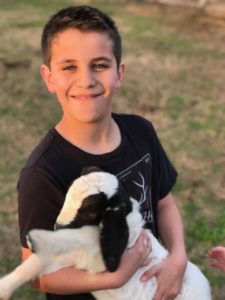How they met
Emily and Philip Ives met when they began working at the Arkansas Sheriffs’ Youth Ranches nine years ago.
“Before we were hired at the Ranch, we worked across the street from one another for years unknowingly,” Emily laughs.

Emily and Philip Ives
Emily graduated from Lyon College, and Philip graduated from Arkansas State University. Emily, who is now the Ranch’s Business Manager, joined the Ranch team as Director of Communications and was recently promoted to Business Manager. Philip, originally hired as Program Manager, was promoted to Chief Operating Officer a few years ago.
Over time, the two became quite a team. Emily and Philip collaborated to keep things running smoothly on a daily basis at the Ranch.
“I was born and raised as part of the Ranch family. My parents have been houseparents for literally over 1000 kids over the course of my life. Being here as part of the Ranch has always been my normal, but as I grew up, I realized that other families do not help take care of kids like my family did,” Emily says.
Becoming a family

Celebrating becoming a family of four
Emily and Philip’s relationship evolved over time. They married and celebrated the birth of their son, Dash, a few years later. They adopted their son, Isaac, from the Arkansas Sheriffs’ Youth Ranches on November 1, 2018. Isaac came to the Ranch as a foster child four years prior to adoption.
“We spent time around him often since we work at the Ranch, but we didn’t build a strong relationship immediately. Since he lived in the home where Emily’s parents work as houseparents, we had ample opportunity to interact with him,” Philip recalls.
When Philip and Emily learned that Isaac would be eligible for adoption, they were concerned for his well-being.
“We thought his quality of life may decrease. He does not adjust well to change. Also, we hated to see him separated from his siblings,” Emily shared.
Life for foster children at the Ranch
The length of stay at the Arkansas Sheriffs’ Youth Ranches varies for children who call the Ranch home. Some stay for a few months before transitioning to traditional foster homes, while others stay at the Ranch and remain for years. Others, like Isaac, are deemed eligible for adoption and leave when they find forever homes.
The Department of Child and Family Services (DCFS) or The Department of Human Services (DHS) retains legal custody of foster children who call the Ranch home. The Arkansas Sheriffs’ Youth Ranches provides more than just foster care for Ranchers. Ranch staff offer loving, supportive family-style homes and keep siblings together. The Ranch provides therapeutic services, academic support, and life skills training. And in the summer, Ranchers enjoy fun, educational programs and activities on the Ranch’s nearly 600-acre campus.
Isaac, like other Ranchers, enjoyed living at the Ranch. The Ranch provided stability, security, and support. His previous living environment lacked these key components to emotional, mental, and physical well-being. When Philip asked Isaac if he would like to be adopted, he looked at him blankly, as if he’d never considered that option. After several minutes, he said yes and asked several questions.
Adopting Isaac

Isaac as a Rancher
The process of adoption began—but the adoption process takes time. The Ives family first expressed their intention to adopt Isaac. Then, they agreed to participate in several weeks of fostering and parenting courses through DHS. The series of courses educates potential adoptive parents about what to expect when fostering and adopting, provides parenting tips and techniques, and helps parents manage behavior problems, including power struggles. Philip recalls hearing many stories from course teachers about difficult situations.
“Our teacher he let us know it was not going to be all rainbows,” he remembers.
In addition to coursework, Emily and Philip underwent CPR certification training and DHS home visits.
“We let Isaac visit our home before fostering. When we showed him his bedroom, he jumped on the bed and spread his body across it. He really seemed at home,” Emily muses.
Adoption celebrations and challenges
While Emily and Philip share fond memories of Isaac’s adoption, they also admit to difficult moments.
“The first night felt very awkward. We told him he may be bored at our home because life is normal in our home. And all of a sudden, we realized we had a teenage stranger walking around. We needed to create more boundaries,” Philip notes.

Isaac today
The first six months required adjustment for everyone, including Dash, the Ives’ biological son, now five years-old. Emily and Philip agree that the greatest challenge was proving to both boys that they were equally loved.
“We had to help Isaac believe we loved him as much as Dash, that he wasn’t just a side note, that we valued his thoughts and interests, that life would be fair. And we had to do the same for Dash,” Philip shares.
Over time, the couple found balance with the children but faced struggles in the process. The couple also helped Isaac cope with anxiety. Prior to adoption, Isaac struggled academically and behaviorally in school due to anxiety. However, after the adoption was finalized, many of his fears about the future subsided. Isaac now remains on the Honor Roll at school, and his parents do not receive negative feedback from teachers or administrators.
“Now we argue about cleanliness and normal things,” Emily comments.
Life today for the Ives family
Isaac and Dash spend time together attending church, watching television, playing video games, and pestering one another. Dash loves playing with his goats, pigs, and prize cat, Ricky Bobby. Isaac enjoys football and basketball. In fact, he has always dreamed of attending a NFL game. Philip and Isaac will attend one together this fall to see the Atlanta Falcons and Dallas Cowboys go head to head.
Emily and Philip offer tips and advice to other families considering adoption.
“Even after working at the Ranch, I remained naive about the process and had unrealistic expectations. Past trauma will come out. Personalities clash. Gratitude will not overflow. Just be realistic,” Philip urges.
“And I didn’t know my child’s love for his biological parents would remain so strong. But it has helped me tremendously to look at all things through my child’s eyes,” Emily shares.
Thank you, Philip and Emily, for your daily contributions to the lives of children at the Arkansas Sheriffs’ Youth Ranches. We hope all readers will consider joining us in supporting children who call the Ranch home by becoming a Hope Builder and making a monthly donation toward building better lives for Ranchers.








